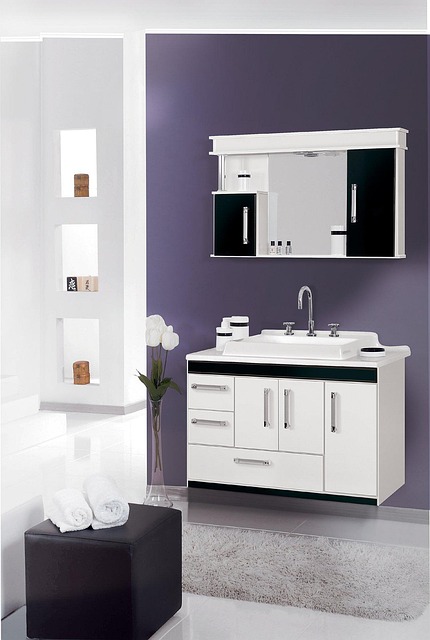When choosing bathroom flooring, prioritize waterproof solutions for safety and longevity. Luxury vinyl is a top pick due to its durability, design versatility (mimicking ceramics or marble), ease of installation, and repairability. Slip-resistant surfaces, like ceramic and porcelain tiles with anti-slip coatings, are essential in wet areas. Natural stone (e.g., marble) requires proper sealing and maintenance to prevent water absorption and slipping hazards. Balancing aesthetics, functionality, and safety, waterproof flooring options save costs, reduce accident risks, and enhance your bathroom's visual appeal.
Transform your bathroom into a luxurious sanctuary with the perfect flooring solution. From sleek and stylish to practical and durable, the array of bathroom flooring options available caters to every taste and budget. This comprehensive guide explores top choices, including waterproof options for protection against moisture, slip-resistant surfaces for safety, and classic natural stone for timeless elegance. Discover the benefits, materials, installation tips, and design possibilities that will elevate your space.
- Waterproof Bathroom Flooring Solutions: Protecting Your Investment
- – Benefits of waterproof flooring in bathrooms
- – Types of waterproof bathroom flooring materials
- – Installation and maintenance tips
Waterproof Bathroom Flooring Solutions: Protecting Your Investment
When it comes to waterproof bathroom flooring solutions, luxury vinyl tops the list as a popular choice among homeowners. It offers an extensive range of designs imitating ceramic, porcelain, or even natural stone and marble, without compromising on durability and water resistance. Vinyl is easy to install, maintain, and replace if damaged, making it a practical option for busy households.
Slip-resistant surfaces are another critical aspect of safe bathroom flooring. Ceramic and porcelain tiles, known for their timeless beauty and versatility, can be enhanced with anti-slip coatings to ensure safety in wet conditions. Natural stone flooring, such as marble, exudes elegance but requires proper sealing and maintenance to prevent water absorption and slipping. Choosing the right waterproof bathroom flooring solution not only protects your investment but also contributes to a safer environment for all users.
– Benefits of waterproof flooring in bathrooms
Waterproof flooring is a top choice for bathrooms due to its numerous benefits. First and foremost, it offers unparalleled protection against moisture. Water can cause traditional flooring materials to warp or rot, but waterproof options are designed to resist water absorption, ensuring your floor remains intact even with frequent contact. This feature not only adds longevity to your bathroom flooring but also prevents costly repairs or replacements.
Additionally, waterproof bathroom flooring provides enhanced safety through improved traction. Slippery surfaces are a common concern in wet environments, but slip-resistant materials significantly reduce the risk of accidents. Luxury vinyl and porcelain tiles, for instance, can be engineered with anti-slip properties, making them ideal choices for busy households or commercial spaces. Moreover, these floor types offer a diverse range of aesthetics, from the classic look of ceramic or porcelain bathroom tiles to the elegant marble flooring, catering to various design preferences while maintaining functionality and durability.
– Types of waterproof bathroom flooring materials
When it comes to choosing waterproof bathroom flooring, there are several high-end options that offer both style and durability. One popular choice is luxury vinyl flooring, which comes in various designs imitating ceramic or porcelain tiles. It’s an excellent pick for bathrooms due to its water resistance, ease of installation, and low maintenance. Vinyl flooring can withstand moisture, making it a practical and trendy bathroom flooring option.
Another classic and elegant choice for bathroom flooring is ceramic and porcelain tiles. These materials are known for their durability and ability to create visually stunning patterns and textures. Ceramic and porcelain tiles offer excellent slip-resistant properties when chosen with the right finishes, ensuring safety in wet environments. Natural stone flooring, such as marble, provides a luxurious and timeless look, but it requires more maintenance and can be pricier compared to other options like vinyl or ceramic tiles.
– Installation and maintenance tips
When it comes to installing and maintaining your chosen luxury bathroom flooring solution, there are several key considerations to ensure longevity and aesthetics. For waterproof bathroom flooring options like luxury vinyl or porcelain tiles, proper installation involves sealing gaps and joints to prevent water infiltration. Regular cleaning with non-abrasive products is crucial for preserving the finish, especially with slip-resistant varieties that enhance safety without compromising style.
For natural stone or ceramic bathroom tiles, setting them correctly with a suitable adhesive and grout ensures they remain sturdy against moisture and humidity. Annual sealing of stone floors can help protect against stains and maintain their radiant look. Marble bathroom floors, known for their elegance, demand regular polishing and a dedicated cleaning routine to preserve their glossy surface while preventing etching from acidic products.
When it comes to transforming your bathroom into a luxurious oasis, the right flooring is key. Waterproof bathroom flooring solutions not only protect against moisture and humidity but also offer a range of stylish options from luxury vinyl to ceramic and porcelain tiles, and even natural stone like marble. Choosing slip-resistant materials ensures safety without compromising aesthetics. With the right installation and maintenance, your new bathroom flooring will withstand the test of time, enhancing both functionality and the overall ambiance of your space.
